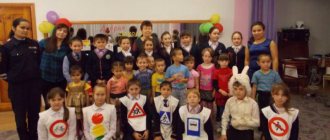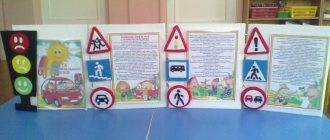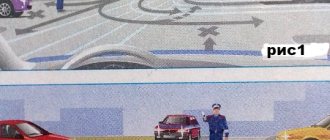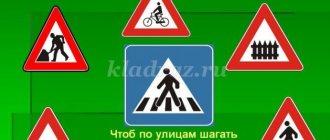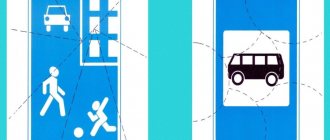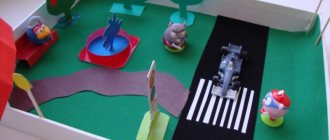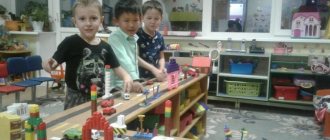Did you know that a children's playground can be designed in such a way as to teach children the rules of the road?
Nowadays, children from a young age need to be taught proper behavior on the streets. Of course, the baby acquires basic skills in everyday movements with his parents: at crossings, at stops, in front of traffic lights, etc. But children learn all knowledge more easily through play, and it will be great if they can master the basic rules of the road while playing on the playground.
Road signs on the playground
While having fun, children will be able to get acquainted with the meaning of some road signs, “play out” certain situations on the road and understand the importance of attentive and safe behavior
Game road signs will clearly show what real signs look like. These are not paper signs, but real stationary signs, of good quality and made from environmentally friendly materials.
With their help, you can arrange a small section of the roadway with traffic lights, pedestrian crossings, intersections, and various signs. Both “pedestrians” and “vehicles” will be able to play here: children on scooters, bicycles, electric cars. While playing, children can learn to walk on sidewalks, cross the road at pedestrian crossings, follow traffic lights, etc.
Basic requirements for children's car parks
Annex 1
Basic requirements for children's car parks.
Description of motor towns
A motor town is an area with an area of 1000 m2 (maximum area is not limited) with road infrastructure (a network of roadways, sidewalks and driving areas) and technical means of organizing traffic (traffic lights, barriers, road signs, road markings). The geometric characteristics of the motor city equipment and the width of the roadways are adopted in accordance with the requirements of GOST R 52290-2004 “Technical means of organizing road traffic. Road signs. General technical requirements", GOST R 51256-99 "Technical means of organizing road traffic. Road markings. Types and basic parameters. General technical requirements”, GOST R 52282-2004 “Technical means of organizing road traffic. Road traffic lights. Types and basic parameters. General technical requirements. Test methods", GOST R 52289-2004 "Technical means of organizing road traffic. Rules for the use of road signs, markings, traffic lights, road barriers and guide devices" and are proportionally reduced in accordance with the anthropometric data of children, which improves students' visibility, understanding and correct perception of the road situation, as well as ease of operation and maintenance.
Stationary motor town: Construction of a stationary motor town is carried out on the basis of design documentation. The covering of roadways and sidewalks is made of fine-grained asphalt concrete on a sand-crushed stone base. Curb stones are installed along the edges of roads. Covering walkways and sidewalks is possible using concrete paving slabs for better aesthetics. Areas without a hard surface are covered with a layer of vegetation for subsequent landscaping. The equipment of the motor city (road signs, traffic lights, models, pavilions) is installed permanently with concreting in the ground. To simulate traffic situations, an additional set of portable road signs is provided. Control of traffic lights and barriers in a motor city is carried out using an ASUD (automated traffic control system), which includes: - Wireless control panel for a motor city “AG-2” - a single device that allows you to change the operation states of traffic lights at any traffic light facility in the motor city in three options: manual mode, autonomous mode, night mode; — Road controller — combines a receiving device and a decoder that receive and process the signal from the control panel; - Power cabinet - stationary power supply unit for motor vehicle equipment; — Cable line is an underground power supply network for the equipment of the auto camp, laid in polypropylene pipes. In various versions, the motor city may include additional equipment that simulates various traffic situations: - “public transport stop”, “medical station”, “service station”, “gas station”, “traffic police post” pavilions; — double-sided layouts of “school”, “kindergarten”, “cinema”, “culture and recreation park”, “shop”, “residential building”; — IDN (artificial road hump); — “Tunnel” design with reversible traffic, regulated by transport reversible traffic lights; — Layout “Railway crossing” regulated (optional) by traffic lights, barriers, road signs. A motor city improvement project may include: - Tribunes for spectators; — Garage hangar for storing mini-cars; — Dry toilet; — Fencing the territory; — Lighting. Each motor vehicle town is equipped with an information marker stand “Responsibilities of pedestrians and drivers in a motor vehicle town. Scheme of the motor city.” The special coating of the stand allows you to apply images on the map of the motor city with a marker and then erase them and conduct theoretical classes and instructions with students.
Motor city with portable equipment: If there is an existing asphalt site for a motor city, a construction project is not required. The road network is applied to the surface with road marking paint. Equipment (traffic lights, road signs) is installed on portable bases. Each traffic light object is powered by a battery installed at the base of one of the traffic lights. Ground-based cable lines are installed and covered with a protective metal profile. Traffic light objects are controlled using control panels UP-1 (control of one traffic light object) and UP-3 (up to three traffic light objects). Portable equipment for the motor city is easy to install/dismantle and operate. Installation is carried out in a short time according to the instructions included in the delivery set. After classes are completed, the equipment can be easily dismantled and stored. The use of rechargeable batteries to power traffic lights allows operation independently of existing power sources. To ensure uninterrupted operation, each traffic light object is equipped with an additional battery and charger.
The construction of children's motor towns, the organization on their basis of basic educational and methodological centers for the study by children, as well as the teaching staff of general education and preschool institutions, of the fundamentals of road safety is carried out in order to form in children stereotypes of safe behavior on the streets and roads.
A motor town is a fenced area on the territory of general education or preschool institutions, which includes elements of the city road network with road markings, traffic light objects, road signs and small architectural forms. The dimensions of the motor city depend on the level of the institution and the saturation of elements and can reach 60x30 m.
The surface of the town is a fundamental factor in the construction of a motor town, since classes are held on its territory for children of preschool and school age. It should be convenient, safe, aesthetic and multifunctional in its application. The coverage on the territory is classified as: “road”, “pedestrian path”, “island”. A universal (classic) option is a combination of materials: “road” and “pedestrian path” are asphalt concrete, and the “island” is landscaping on peat soil.
To separate the roadway from green areas and sidewalks, curbs (curbs, side stones, side structures) are installed.
Road markings are applied to the roadway (“road”) using specialized marking machines, reduced proportionally, in accordance with GOST R51256-99 and the parameters of roadside infrastructure.
Traffic lights are manufactured in sections of two types:
| transport (three signals) | pedestrian (two signals) |
The sections are installed on racks using fastening and joint elements and, if necessary, can be easily dismantled. The diameter of traffic light signals is 100 mm. The basis of light signals - LED ultra-bright matrices - is a safe and attractive light source due to high reliability, low heat generation, high vibration resistance and mechanical strength, low energy consumption and ultra-long service life. Traffic lights are manufactured in accordance with GOST R52290-2004, R52282-2004, changed proportionally in size, according to the anthropometric data of children. Wear-resistant materials are used in manufacturing, and the housing design is dust and waterproof. Traffic lights are frost-resistant, resistant to high humidity, solar radiation, and frost. Light signals eliminate the occurrence of a false signal when illuminated by sunlight. Traffic lights are controlled using a control panel (supply voltage 12 V) in the following modes: 1) three options for the duration of control cycles for traffic light objects; 2) the motor city operates completely automatically; 3) the motor city operates entirely in manual mode; 4) operation of traffic light objects both manually (switch keys on the traffic light section and control panel) and in automatic mode in various positions (i.e., on any traffic light object);
Road signs are made with the application of reflective film, in accordance with GOST R52290-2004, R52282-2004, changed proportionally in size, according to the road infrastructure of the motor city. They are installed on stands (up to three pieces), using the fastening of a road sign located on the back. The base is stationary or portable. When the teacher changes the task (traffic situation), the signs are easily dismantled and the following ones are installed.
Small architectural forms are elements of children's playgrounds (slides, swings, carousels, houses, sandboxes, models of vehicles, etc.) and are intended to facilitate the process of conducting classes with children of preschool and primary school age. All elements are created industrially and certified.
In motor towns, overground pedestrian crossings can be built, combined with small architectural forms and stylized as architectural monuments.
Transport areas for classes
according to the traffic rules.
EQUIPMENT OF TRANSPORT SITES
For schoolchildren and primary schoolchildren, the most effective form of studying the Rules of the Road is a game-activity, which can be carried out both outdoors and indoors. To conduct practical classes, games, competitions for better knowledge and implementation of traffic laws, transport areas are intended, which must be equipped in every school and children's educational institution.
The transport platform (vehicle platform) is a complex consisting of the following elements:
paved area with roadway markings;
means of regulation (traffic lights, road signs), which can be made by the children themselves during labor lessons;
transport (pedal cars, cyclists, scooters);
educational materials and attributes of games and activities (staffs, uniforms of young traffic inspectors, etc.);
stationary or portable display cases (boards) with propaganda materials (posters, memos, leaflets) for conducting classes.
Such a parking lot can be located on the territory of a school, kindergarten, cultural park, residential neighborhood, or health camp. The boundaries of the roadway and sidewalk are applied to the asphalt with white paint (width 0.07-0.1 m). It is advisable to make road signs and panels from metal, on stands with a stand (the height of a sign, a panel with a stand is 1 - 1.2 m). When painting signs, be guided by the existing GOST.
Educational authorities, motor transport enterprises, city and district councils of the All-Russian Society of Motorists and other sources can provide assistance in the production of signs, panels, attributes for games, in the acquisition of transport, uniforms for young traffic inspectors.
Based on local conditions, it is possible to select schemes of varying complexity for vehicle sites.
Examples of basic children's transport playgrounds are shown in the diagrams in the appendix.
Games and exercises on the playground should be carried out after children have been previously familiarized with the Traffic Rules during classes in kindergartens and schools. Their goal is to expand children’s initial knowledge about the rules of traffic and pedestrians and teach them to follow the rules of behavior on the street.
To increase the capacity of the site, it is advisable to provide for the participation in classes of two classes (groups, squads) simultaneously, one of which plays the role of pedestrians, the other of vehicle drivers. After a certain point, the groups change roles.
Upon arrival at the site, the teacher (educator, member of the youth development team) introduces the children to the layout of the site, the organization of traffic on it (markings, road signs, signs, traffic lights), draws the children’s attention to the need to strictly adhere to the rules (do not drive into oncoming traffic, obey distance, interval, overtaking must be done only on the left side, comply with the requirements of road signs, traffic lights or traffic controllers).
To conduct the game-activity, 5-7 young traffic inspectors are allocated, who must have batons, whistles, an armband or a UID uniform. They monitor the movement of vehicles and pedestrians on the parking lot;
The simplest territory of a preschool educational institution, a training ground in the form of an intersection, can be equipped in the courtyard of the preschool educational institution, and in the winter in the lobby of each school.
Get text
